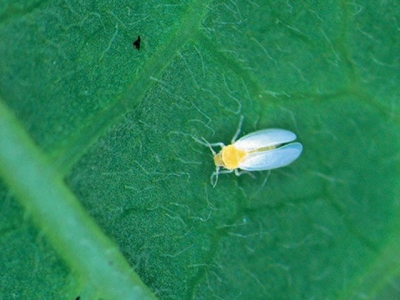How to spray for whitefly

I receive many emails from desperate growers wanting to know what to spray against this insect. While some new pesticides have proven effective, they are not always registered for the crop being grown. Then there are the organic growers who are not permitted to spray chemical pesticides.
Whitefly remains a notoriously difficult pest to control.
If it were not for the natural enemies of this pest, whiteflies would probably be our main vegetable pest. An outbreak of whitefly is usually the result of using crop chemicals harmful to these predators.
Different species
We have to deal with two species, namely, the greenhouse whitefly (Trialeurodes vaporariorum) and the sweet potato or silverleaf whitefly (Bemisia tabaci). The latter attacks nearly 1 000 plant species and the former about 700.
Initially, insecticides were used successfully for control, but the whitefly’s short life cycle means that resistance builds up quickly and new chemicals are constantly needed to control the pest.
Whiteflies are very small insects that take flight when disturbed on leaves, often in clouds due to their high infestation rate.
Their size and flight pattern allow them to quickly disappear from sight, which is why they are often referred to as ghost flies.
Whitefly females lay up to 200 eggs on the underside of leaves. These hatch in five to seven days. Low temperatures, however, will extend each stage of the life cycle.
After hatching, the nymphs start to feed on leaves by piercing the leaf surface and sucking the sap. Over a period of four to five weeks, the nymphs moult four times before pupating.
Sooty mould
Like aphids, whitefly nymphs excrete a sticky, sweet honeydew. Ants collect this, which protects the nymphs from natural enemies, keeping their food sources secure.
Honeydew is also a good medium for sooty mould to develop. In this case, as thename implies, black soot-like mould covers the leaves, preventing them from using sunlight.
The honeydew drops from the feeding nymphs affect the leaves the flies feed on. It is easy to imagine how the large amounts of sap consumed can hamper plant growth.
More harm
Worse still, more harm is often done to the crop by the diseases whiteflies transmit than by the physical damage they inflict.
For example, the relatively newly introduced curly stunt virus, found in tomatoes in our warmer areas, is transmitted by whiteflies. The disease can cause close to 100% crop loss.
The wide range of host plants means whiteflies can potentially be everywhere, so conserving their enemies is all the more important. I’ll discuss this in the next issue.
Related news
 Using a knapsack sprayer on a big farm
Using a knapsack sprayer on a big farm Many farmers think that using a knapsack sprayer is taking a step backwards as large spray rigs are fast and effective. However, knapsack sprayers still have
 Sandy soil: a guide to working with it
Sandy soil: a guide to working with it Vegetable expert Bill Kerr discusses how to get the best out of sandy soil, regardless of what crop you’re growing.
 Spraying tips: Don’t mix chemicals
Spraying tips: Don’t mix chemicals When spraying different pests at the same time, many farmers try to kill two birds with one stone by making elaborate mixtures.